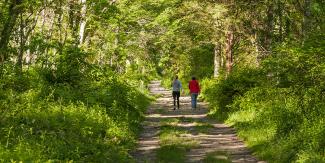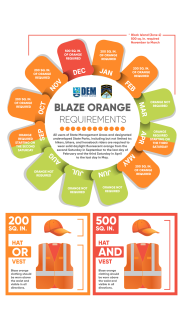Trail Etiquette

- Hikers coming uphill have the right of way. If you’re descending the trail, step aside and give space to the people climbing up.
- Bicyclists yield to hikers and horses. Come to a full stop and step to the side to give the right of way. Be mindful of the plants or animals that are near the trail if you must step off the trail.
- Hikers yield to horses. Slowly and calmly step off to the downhill side of a trail. If you approach from behind, calmly announce your presence and intentions. Horses can frighten easily, so avoid sudden movements or loud noises.
- Respect signage that restricts or disallows dogs. It may seem disappointing to not be able to take your dog exploring, but they can cause a lot of problems for wildlife (stress, disease, predation). Whether posted or not, dogs should be leashed to keep them away from wildlife and their homes and nests, especially during the breeding and nesting seasons. Please pick up after your dog and take it with you! Never leave bags of dog waste at trailheads, along trails, or the woods.
- Remember to know where you need to wear safety orange!
- When in doubt about something just remember the "golden rule" — treat other trail users how you want to be treated, and respect wildlife and our natural places.
- Learn more trail tips here
FLUORESCENT ORANGE REQUIREMENTS
Orange safety clothing must be worn by everyone in state management areas and undeveloped state parks, including hikers, bikers, and horseback riders, to stay visible to hunters. Solid fluorescent (blaze) orange must be worn above the waist and be visible in all directions. Examples are: a hat or vest that covers 200 square inches or a combination of hat and vest covering 500 square inches. Bright yellow and fluorescent camouflage do not meet this requirement.
Where to wear orange Planning a hike and unsure if a location allows hunting? Look for signage at the site, visit ExploreRI.org or use the DEM's interactive Outdoor Recreation map.
Hunters in Rhode Island are responsible and public lands remain safe for all visitors to enjoy while following this safety requirement. By wearing orange and being aware of hunting seasons, non-hunters can ensure they are visible and stay safe. Hunter education is offered as part of DEM Division of Fish & Wildlife's Hunter Education Program and safety training is required by law in Rhode Island for beginning hunters. Hunters are taught to clearly identify a target and what is beyond it before shooting. To date, more than 40,000 people have completed a hunter safety course in Rhode Island, helping to reduce related accidents in the state and elsewhere.

- 200 sq. in. by small game hunters during the small game season, fall turkey hunters while traveling, and muzzleloader deer hunters during the muzzleloader deer season.
- 200 sq. in. by archers when traveling to/from elevated stands during the muzzleloader season. Once in an elevated stand, archery deer hunters are exempt from the orange requirement during the muzzleloader season.
- 500 sq. in. by all hunters (including archers) and all users of management areas and undeveloped state parks during all portions of shotgun deer seasons.
- Hunters using pop-up blinds during the firearms deer season must display 200 square inches of fluorescent orange visible on the outside of the blind from all directions. Hunters must also wear orange in accordance with the rules for the specific seasons while in the blind.
- Exemptions: Raccoon hunters when hunting at night, crow hunters while hunting over decoys, spring turkey hunters, first segment dove hunters, and waterfowl hunters while hunting from a boat or a blind, over water or field, when done in conjunction with decoys. Fluorescent orange is not required in areas limited to archery-only hunting by regulation.
- All other users of state management areas and designated undeveloped state parks, including but not limited to: hikers, bikers, and horseback riders are required to wear 200 square inches of solid daylight fluorescent orange from the second Saturday in September to the last day of February and the third Saturday in April to the last day in May.
